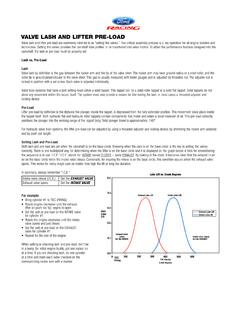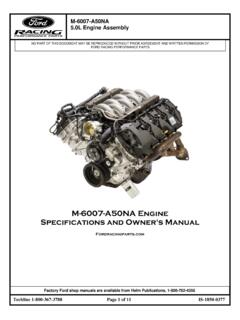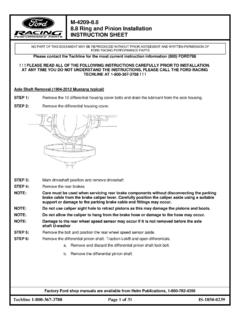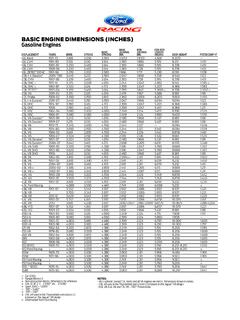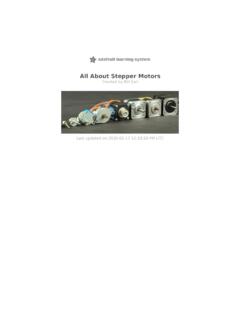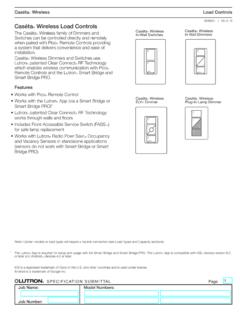Transcription of FOUR-CYLINDER ENGINE SECTION - Ford Motor Company
1 FOUR-CYLINDER ENGINE OHV KENT ENGINEOpen-wheel racing enthusiasts associate this overhead valve design with the long-lived international Formula Ford series, the starting point for many professional drivers. Most of the combustion chamber is in a dished piston, where the mating cylinder head face is nearly flat. Production for European models (Cortina, Capri and Fiesta) is now phased out. Ford Racing sold numerous production-type parts for Formula Ford competition. SOHC CVH OR SPI ENGINESThe two-valve CVH (Canted Valve Hemispherical) ENGINE was introduced with the 1981 Escort and later used in Focus. The layout is also called Cam in head, because it resembles a classic overhead valve geometry.
2 A single overhead camshaft lifts up hydraulic lash adjustors, linking individually mounted rocker arms to valves canted at angles relative to the cam axis, as well as front to rear, to match the shallow hemispherical chamber. Manufactured at Dearborn (Mich.) ENGINE Plant, it was replaced by the Duratec HE ENGINE family. DOHC MAZDA ENGINESIn the early 1990s, Mazda -manufactured four-valve engines were shared with Ford applications. The was introduced on 1991 Australian-made Mercury Capri (including a turbocharged variant), the on 1991 Escort GT, and the on the 1993 Probe. Ford Racing parts were not developed for this iron-block architecture, which was replaced by the Zetec and eventually Duratec I-4 ENGINE DOHC ZETEC ENGINESB ased on the CVH ENGINE bore centers, this iron- block four-valve was developed for the 1994 Mondeo/Contour world car, and later shared with the Escort and Focus.
3 Manufacturing sites were Cologne, Bridgend (Wales), and Chihuahua (Mexico). Launched with hydraulic bucket tappets, it was later converted to light-weight mechanical (solid) tappets. Ford Racing parts were developed with its Focus usage, including a 170 horsepower SVT Focus, the USAC Ford Focus Midget Series, and SCCA F2000. The production Zetec was superseded by the Duratec SOHC ENGINESFord's first North American metric ENGINE featured a belt-driven overhead cam and finger- follower valve train, while retaining traditional cast iron block and head. The SOHC was the base ENGINE of numerous 1974-1997 models, including Mustang, Pinto, Fairmont, Ranger, and early Aerostar vans.
4 A turbo version was launched with the new 1979 Fox Mustang, with a 2nd generation port-fuel-injected (PFI) turbo powering the 1983 Thunderbird Turbo Coupe, Mustang SVO, and later the Merkur XR4Ti. A twin spark plug head with Ford s first coil-pack distributorless ignition was introduced on 1989 Ranger and 1991 Mustang models. The Ranger also offered a smaller bored version in the mid- 80s; its last iteration was the stroked 1998-2000 Ranger. Lima (Ohio) ENGINE Plant provided most production, supplemented by Taubate (Brazil). Ford Racing parts were developed for the SOHC, including a partnership with Esslinger Engineering for an aluminum cylinder head. Ongoing racing usage includes the SCCA F2000 European SOHC was produced for 1971-1974 cars.
5 While conceptually similar, it was dimensionally unique in terms of bore, stroke, bore spacing, block deck height, and crankshaft journal diameters. 3V SOHC PROBE ENGINEThe 1989 Probe launched with a Mazda -sourced overhead cam three valve (2 intake, 1 exhaust), in naturally aspirated and turbo versions. Ford Racing parts were not developed for the OHV HSC ENGINESThe 1984-1994 Tempo/Topaz High Swirl Combustion (HSC) ENGINE resembles Ford s classic cast iron push rod 200 cid I-6, with two cylinders removed. The 1986-1990 Taurus offered a version, but most customers wisely chose an available DOHC SIGMA ENGINESFord s first aluminum block I-4 arrived with the 1997 Fiesta, internally designated as Sigma.
6 Primary design work was contracted to Yamaha, with original manufacturing in Valencia (Spain) and later at Bridgend (Wales) and Taubate (Brazil) plants. In this compact design, double overhead cams actuate mechanical bucket tappets. The 2011 Fiesta is the first North American production application, with twin- independent variable cam timing (Ti-VCT) increasing fuel economy and power. The turbocharged EcoBoost variant provides up to OHC (Turbo-Intercooled) OHC178 horsepower in North American Fusion and Escape applications. Ford Racing offers a growing number of parts, including key components for B-Spec race DOHC ENGINESM azda led initial design of this aluminum-block world ENGINE , which replaced five other large FOUR-CYLINDER ENGINE families starting in 2001, with manufacturing in Mexico, Dearborn, Valencia (Spain), and China.
7 Early North American applications included Ranger, Focus, Fusion, and Escape, with a specific late closing intake cam (Atkinson Cycle) on hybrid applications. Dearborn ENGINE Plant is the exclusive source of the gas-direct-injection (GDI) twin-independent variable cam timing (Ti-VCT) upgrade launched for the new 2012 Focus, developing 160 horsepower. Chihuahua and Valencia ENGINE Plants provide the intake-VCT ENGINE , for North American Escape, Fusion, Fusion Hybrid, C-Max Hybrid, and Transit Valencia-built Gas Turbo Direct Injection (GTDI) version launched for the European Mondeo. In the 2012 Ford Explorer and Edge, the GTDI enables up to 30 miles per ( ) gallon highway, for fuel economy leadership.
8 Other versions are used in the Falcon (Australia), as well as Land Rover and Volvo applications. For 2013, Fusion, Escape, Taurus, Focus ST, and even Lincoln MKT limo applications are added, with 240-247 horsepower. As a result, this ENGINE architecture is offered in every North American vehicle platform except Fiesta and full-sized DOHC 4V DURATEC ENGINEThe small ENGINE compartment of the 1994 Contour (Mondeo in Europe) required a compact design, with a short forged steel crank and rear-mounted cam-driven water pump. An aluminum block casting process was licensed from Cosworth, which rotates the sand mold during metal solidification to improve quality. Subsequent applications included Taurus, Cougar, Escape, Mazda MPV, Mazda 6, Freestyle, 500, and Fusion.
9 Initial concept design work was contracting to Porsche Engineering, resulting in a full main bearing girdle similar to the Porsche 928 V8. Roller finger follower (RFF) aluminum cylinder heads resemble the 4V, although more compact. The 199x SVT Contour tuned the to 200 horsepower, with Extrude-Hone cylinder heads improving airflow. Low-profile mechanical bucket tappet heads were developed for the Jaguar S-Type/Lincoln LS packages, and later applied to the All-Wheel-Drive X-Type in (European sales), , and variants. 2010-2012 versions were upgraded with variable cam timing (VCT) and identified internally as the D30 PI. Aftermarket V6 applications have included the turbocharged Noble sports car from South Africa.
10 Aston Martin s V12 is based on this architecture. DOHC 4V PROBE ENGINEThe 1993 Probe used this all-aluminum Mazda design, shared with the Mazda 626 and further developed for the Mazda Millenia's Lysholm supercharged Miller-cycle. Mazda replaced this ENGINE family with Ford-designed V6s. OHV/SOHC 2V COLOGNE ENGINEFord of Germany developed a 1961 OHV 60-degree V-4 to a V6 for North American Capri, Bronco II, Mustang II, Ranger, and Merkur Scorpio sales, then expanded it to for the 1991 Explorer. The original push rod layout was converted to modular-style single overhead cam 2V heads for 1997 Explorer and 2001 Ranger, using a jackshaft in original block camshaft bore to drive the right-hand cam chain from the rear, and the left-hand cam chain from the front.
